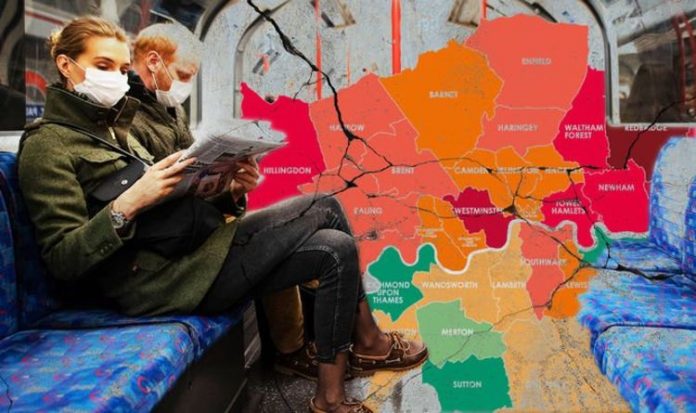London cases have surged in the past week driving Public Health England to put the capital on the UK’s national coronavirus watchlist. The city was placed on the watchlist following a spike in infections. The move comes after 620 new cases were confirmed in the capital in the last 24 hours. But which borough has seen the highest levels of new cases?
London was today placed on the national covid watchlist as an area of high concern.
Areas of concern are those at the lowest end of the PHE’s watchlist and will have some of the highest rates of new infection in the country and in these cases, local councils may opt to take real action.
Public Health England also designates areas as areas of enhanced support, where measures such as mobile testing are implemented, or areas of intervention, where lockdown restrictions are reimposed.
A formal confirmation is due this afternoon from Public Health England but the announcement was made this morning by London Councils, which represents the 33 boroughs.
READ MORE: London coronavirus panic: Capital put on official lockdown watch-list
The organisation London Councils which represents the capital’s 32 boroughs and the City of London said it was a reminder to adhere to the restrictions.
The group said: “It is a stark reminder that now is time for all Londoners to pull together and take action to keep themselves, their families and their communities safe, and to ensure that London’s economy is protected.”
The move comes after 620 new cases were confirmed in the past 24 hours, which is more than double the number at the beginning of the week.
In total, 35 patients were admitted to hospital in the capital in the past 24 hours, taking the total to 212, of which 40 are on ventilators.
Mayor of London Sadiq Khan said: “London is at a very worrying tipping point right now. We’re seeing a sharp rise in 111 calls, hospital admissions, and patients in ICU.
“The near-collapse of test and trace and the resurgence of the virus means new measures to slow its spread were absolutely necessary.
“Testing capacity was diverted away from London in the last two weeks to other national hot spots and weekly testing numbers are now down 43 percent in the capital since mid-August.
“The lack of testing capacity is totally unacceptable and it is why London has been added to the Government’s coronavirus watchlist as an area of concern.
“Ministers simply have to get a grip. It’s vital that testing capacity is increased immediately in London and focused in the areas it is needed most.
“Any delay will mean letting the city down and will cost lives.”
DON’T MISS
Coronavirus UK alert: Scientists issue warning to Boris [INSIGHT]
Care home bans ‘window visits’ between couple married for 63 years [EXPLAINER]
Germany lashes out at EU Parliament in huge budget row [ANALYSIS]
Overall thus far there has been the following number of cases and rate per 100,000 people since the outbreak began:
- Barking and Dagenham: 1,127 cases – 529.3 rate per 100,000 population
- Barnet: 2,198 – 555.2
- Bexley: 1,311 – 528
- Brent: 2,203- 668
- Bromley: 1,824 – 548.8
- Camden: 1,006 – 372.6
- Croydon: 2,210 – 571.5
- Ealing: 2,124 – 621.4
- Enfield: 1,655 – 495.8
- Greenwich: 1,227 – 426.1
- Hackney and City of London: 1,420 – 488.2
- Hammersmith and Fulham: 1,082 – 584.4
- Haringey: 1,153 – 429.2
- Harrow: 1,671 – 665.3
- Havering: 1,390 – 535.5
- Hillingdon: 1,579 – 514.6
- Hounslow: 1,572 – 579
- Islington: 838 – 345.6
- Kensington and Chelsea: 825 – 528.4
- Kingston upon Thames: 936 – 527.3
- Lambeth: 1,850 – 567.4
- Lewisham: 1,534 – 501.6
- Merton: 1,132 – 548.1
- Newham: 1,866 – 528.4
- Redbridge: 1,742 – 570.7
- Richmond Upon Thames: 757 – 387.3
- Southwark: 1,894 – 594
- Sutton: 1,186 – 574.8
- Tower Hamlets: 1,341 – 412.9
- Waltham Forest: 1,417 – 511.6
- Wandsworth: 1,686 – 511.4
- Westminster: 1,134 – 434
Green Party co-leader and London Mayor candidate Sian Berry advised people to stay away from bars and restaurants in the capital in the coming days.
Ms Berry said: “The news today that Public Health England has added London to its list of areas of concern, using estimates from other data, shows what a crucial time this is, and how all our actions can make a difference.
“The 10pm closing time for bars and restaurants has already led to crowded scenes on public transport that worry me greatly.
“My strong advice to Londoners today is to avoid going out in the next few days unless you have to, and find other ways to see friends and family.
“If you have a choice to reduce exposure or put off risky activities, it could make all the difference.”







